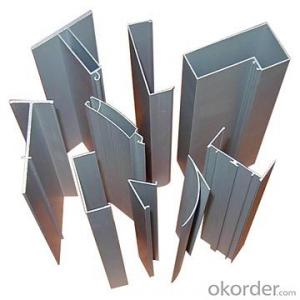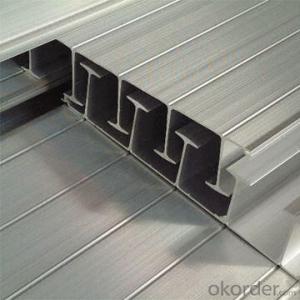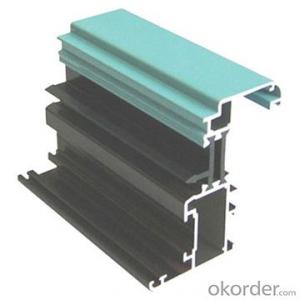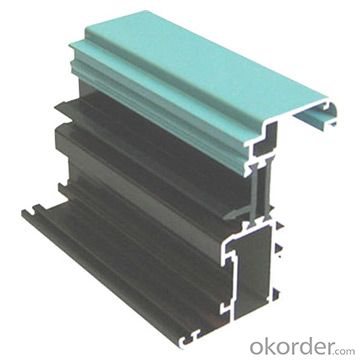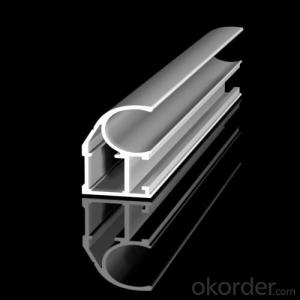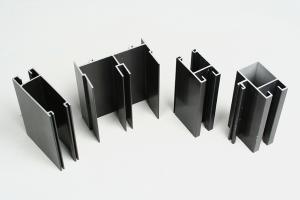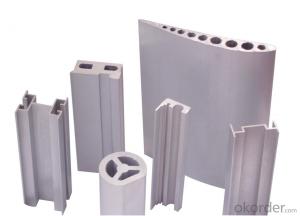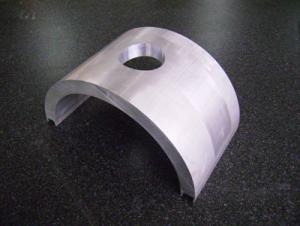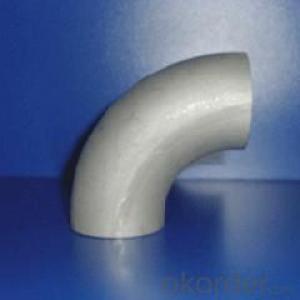Common China Extruded Aluminum Profiles for All Kinds of Surface Treatment Aluminum Profiles
- Loading Port:
- China Main Port
- Payment Terms:
- TT OR LC
- Min Order Qty:
- -
- Supply Capability:
- -
OKorder Service Pledge
OKorder Financial Service
You Might Also Like
Aluminium is a relatively soft, durable, lightweight, ductileand malleablemetalwith appearance ranging from silvery to dull gray, depending on the surfaceroughness. It is nonmagnetic and does not easily ignite. A fresh film ofaluminium serves as a good reflector (approximately 92%) of visible lightand an excellent reflector (as much as 98%) of medium and far infraredradiation. The yield strength of pure aluminium is 7–11 MPa,while aluminium alloys have yield strengths ranging from200 MPa to 600 MPa. Aluminium has about one-third the densityand stiffness of steel. It is easily machined,cast, drawn and extruded.
Features:
Material | Alloy 6063,6061,6005or according to customer’s choice |
Temper | T3, T4, T5, T6 |
Surface | Anodize, electrophoresis, powder coating, PVDF coating, wood grain painting, matted, etc. |
Length | Coating 6.5 meters, Anodizing 6.5 meters, Mill finish 5 meters |
Application | Industrial, electrical equipment(TV set, air conditioner, refrigerator, computer), decoration,construction, transportation |
Custom Made | We can package following with customer's request. |
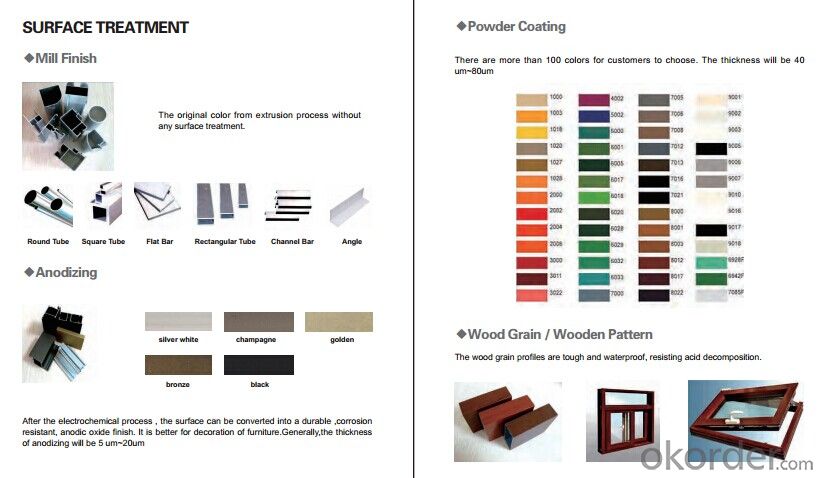
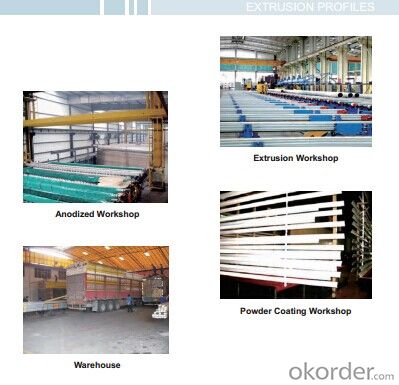
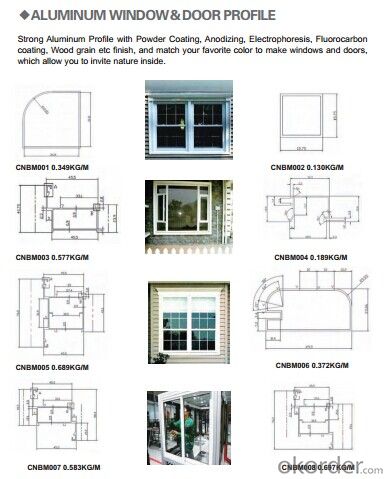
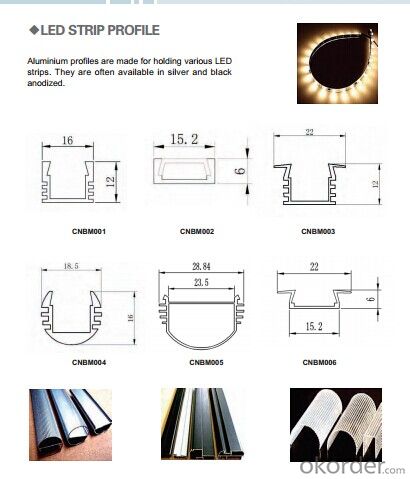
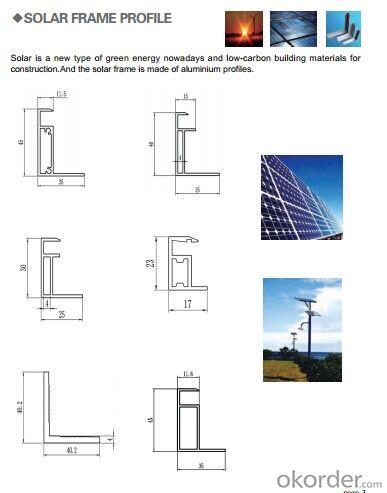
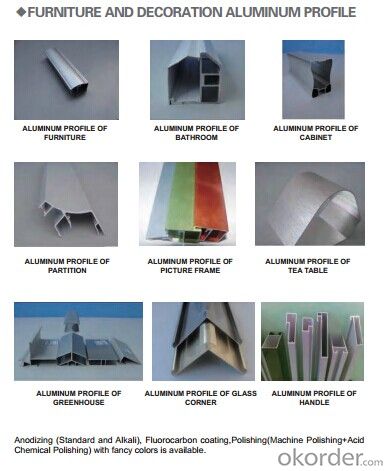
- Q: What are the different surface treatments for aluminum profiles?
- Some of the different surface treatments for aluminum profiles include anodizing, powder coating, painting, and polishing.
- Q: What are the different machining techniques used on aluminum profiles?
- Some of the different machining techniques used on aluminum profiles include milling, drilling, turning, grinding, and tapping. These processes help shape and refine the aluminum profiles to meet specific design requirements and achieve desired dimensions and surface finishes.
- Q: This question asks about the strength and suitability of aluminum profiles for outdoor applications.
- <p>Yes, aluminum profiles are strong enough for exterior use. They are lightweight, durable, and resistant to corrosion, making them ideal for outdoor applications. Aluminum profiles can withstand various weather conditions and maintain their strength over time. They are also low-maintenance, as they do not rust or rot, and can be easily cleaned. Additionally, aluminum profiles can be anodized or powder-coated for enhanced durability and resistance to UV rays, further ensuring their suitability for exterior use.</p>
- Q: Can aluminum profiles be used for balustrades?
- Yes, aluminum profiles can be used for balustrades. Aluminum is a lightweight and durable material that is commonly used in construction for its strength and resistance to corrosion. It is also easy to shape and work with, making it ideal for creating various designs and styles for balustrades. Additionally, aluminum profiles can be powder coated or anodized to provide a decorative finish and enhance its durability. Overall, aluminum profiles offer a practical and aesthetically pleasing solution for balustrades in both residential and commercial settings.
- Q: What are the different shapes and profiles available for aluminum profiles?
- Aluminum profiles come in various shapes and profiles, each with its own distinct characteristics and uses. Let's explore some of the most common options: 1. Square and rectangular profiles: These profiles have straight sides and sharp corners, making them perfect for applications that require strength and rigidity. They are frequently utilized in architectural structures, frames, and support systems. 2. T-shape profiles: T-shaped profiles consist of a perpendicular flange or arm extending from a larger base. They are often employed for structural purposes, providing additional strength and support in beams and columns. 3. Round profiles: Round profiles have a circular cross-section and are frequently preferred in applications that demand a smooth and seamless appearance. They are commonly found in decorative uses like handrails, lighting fixtures, and furniture. 4. Angle profiles: Angle profiles have two sides perpendicular to each other, creating a 90-degree angle. These profiles are commonly used in corner protection, edging, and framing applications. They are frequently seen in industries such as construction, manufacturing, and automotive. 5. I-beam profiles: I-beam profiles feature a central vertical web with flanges on either side, forming an "I" shape. These profiles are renowned for their high strength-to-weight ratio and are commonly used in structural applications like bridges, buildings, and heavy-duty machinery. 6. Custom profiles: In addition to the standard shapes mentioned above, aluminum profiles can also be custom-designed and extruded to meet specific requirements. This allows for endless possibilities in terms of shape, size, and functionality. In conclusion, the wide range of aluminum profile shapes and profiles enables versatility and adaptability in various industries and applications. Whether you prioritize strength, aesthetics, or a combination of both, there is an aluminum profile shape and profile that will suit your specific needs.
- Q: This question asks about the various applications of aluminum profiles within the construction industry.
- <p>Aluminum profiles are versatile in construction and have several uses: 1. Structural framing for buildings, providing support and stability. 2. Window and door frames, known for their durability and resistance to corrosion. 3. Facade systems, offering lightweight and aesthetically pleasing exterior solutions. 4. Modular construction, where aluminum profiles can be prefabricated and assembled quickly. 5. Roofing and cladding systems, due to their weather resistance and ease of installation. 6. Handrails and balustrades for safety and design. 7. Solar panel mounting structures, taking advantage of aluminum's lightweight and strength. 8. Scaffolding systems, for temporary construction support. These applications highlight aluminum's adaptability and strength in construction.</p>
- Q: The subject is aluminum bearing in what u ~ on both sides of the track?? How can the track be fitted into this slot? Both sides secure 50Mechanical expert answers!The subject is aluminum bearing in what u ~ on both sides of the track?? How can the track be fitted into this slot? How can the seat of fixed motor on both sides be connected with the section bar?
- The link between the motor seat and the profile is bolted. Screw holes in the track, and bolts on the motor seat are screwed into the threads of the profiles.
- Q: Can aluminum profiles be used for electrical bus ducts?
- Indeed, electrical bus ducts can be constructed using aluminum profiles. Within the electrical industry, aluminum is widely employed as it possesses exceptional conductivity and lightweight characteristics. Its remarkable electrical conductivity plays a vital role in efficiently transmitting electrical power. Furthermore, aluminum profiles exhibit durability, resistance to corrosion, and the ability to endure high temperatures, rendering them suitable for diverse industrial applications. Nonetheless, it is crucial to carefully assess the project's unique requirements and regulations in order to ascertain that the aluminum profiles conform to the essential electrical and safety standards.
- Q: What kind of equipment are needed for the production of aluminum profiles?
- Upstairs is a very comprehensive aluminum factory ~!Basic ~!1, casting furnace, do not engage, you can also buy aluminum rod production;2. Extruder;3, aging furnace, used to increase the hardness of aluminum profiles;4. Anodic oxidation line;5, other, double head saw, roll bending machine, forklift, crane and other basic equipment needed for the production.
- Q: This question asks if aluminum profiles can be utilized in the construction of environmentally friendly buildings.
- <p>Yes, aluminum profiles can be used for green building applications. They are valued for their durability, recyclability, and energy efficiency. Aluminum is lightweight, which reduces the building's carbon footprint during transportation. It also has excellent thermal conductivity, allowing for better insulation and energy conservation. Additionally, aluminum can be recycled without losing its properties, contributing to a circular economy and reducing waste. These characteristics make aluminum profiles suitable for sustainable construction practices.</p>
Send your message to us
Common China Extruded Aluminum Profiles for All Kinds of Surface Treatment Aluminum Profiles
- Loading Port:
- China Main Port
- Payment Terms:
- TT OR LC
- Min Order Qty:
- -
- Supply Capability:
- -
OKorder Service Pledge
OKorder Financial Service
Similar products
Hot products
Hot Searches
Related keywords
